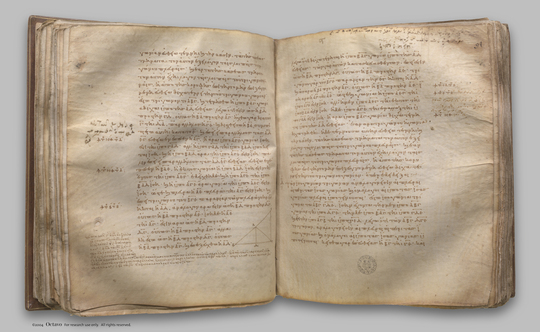index prev next | digilib folio 98

In equiangular triangles the sides about the equal angles are proportional, and those are corresponding sides which subtend the equal angles.
| Τῶν ἰσογωνίων τριγώνων ἀνάλογόν εἰσιν αἱ πλευραὶ αἱ περὶ τὰς ἴσας γωνίας καὶ ὁμόλογοι αἱ ὑπὸ τὰς ἴσας γωνίας ὑποτείνουσαι. Ἔστω ἰσογώνια τρίγωνα τὰ ΑΒΓ, ΔΓΕ ἴσην ἔχοντα τὴν μὲν ὑπὸ ΑΒΓ γωνίαν τῇ ὑπὸ ΔΓΕ, τὴν δὲ ὑπὸ ΒΑΓ τῇ ὑπὸ ΓΔΕ καὶ ἔτι τὴν ὑπὸ ΑΓΒ τῇ ὑπὸ ΓΕΔ: λέγω, ὅτι τῶν ΑΒΓ, ΔΓΕ τριγώνων ἀνάλογόν εἰσιν αἱ πλευραὶ αἱ περὶ τὰς ἴσας γωνίας καὶ ὁμόλογοι αἱ ὑπὸ τὰς ἴσας γωνίας ὑποτείνουσαι. Κείσθω γὰρ ἐπ' εὐθείας ἡ ΒΓ τῇ ΓΕ. καὶ ἐπεὶ αἱ ὑπὸ ΑΒΓ, ΑΓΒ γωνίαι δύο ὀρθῶν ἐλάττονές εἰσιν, ἴση δὲ ἡ ὑπὸ ΑΓΒ τῇ ὑπὸ ΔΕΓ, αἱ ἄρα ὑπὸ ΑΒΓ, ΔΕΓ δύο ὀρθῶν ἐλάττονές εἰσιν: αἱ ΒΑ, ΕΔ ἄρα ἐκβαλλόμεναι συμπεσοῦνται. ἐκβεβλήσθωσαν καὶ συμπιπτέτωσαν κατὰ τὸ Ζ. Καὶ ἐπεὶ ἴση ἐστὶν ἡ ὑπὸ ΔΓΕ γωνία τῇ ὑπὸ ΑΒΓ, παράλληλός ἐστιν ἡ ΒΖ τῇ ΓΔ. πάλιν, ἐπεὶ ἴση ἐστὶν ἡ ὑπὸ ΑΓΒ τῇ ὑπὸ ΔΕΓ, παράλληλός ἐστιν ἡ ΑΓ τῇ ΖΕ. παραλληλόγραμμον ἄρα ἐστὶ τὸ ΖΑΓΔ: ἴση ἄρα ἡ μὲν ΖΑ τῇ ΔΓ, ἡ δὲ ΑΓ τῇ ΖΔ. καὶ ἐπεὶ τριγώνου τοῦ ΖΒΕ παρὰ μίαν τὴν ΖΕ ἦκται ἡ ΑΓ, ἔστιν ἄρα ὡς ἡ ΒΑ πρὸς τὴν ΑΖ, οὕτως ἡ ΒΓ πρὸς τὴν ΓΕ. ἴση δὲ ἡ ΑΖ τῇ ΓΔ: ὡς ἄρα ἡ ΒΑ πρὸς τὴν ΓΔ, οὕτως ἡ ΒΓ πρὸς τὴν ΓΕ, καὶ ἐναλλὰξ ὡς ἡ ΑΒ πρὸς τὴν ΒΓ, οὕτως ἡ ΔΓ πρὸς τὴν ΓΕ. πάλιν, ἐπεὶ παράλληλός ἐστιν ἡ ΓΔ τῇ ΒΖ, ἔστιν ἄρα ὡς ἡ ΒΓ πρὸς τὴν ΓΕ, οὕτως ἡ ΖΔ πρὸς τὴν ΔΕ. ἴση δὲ ἡ ΖΔ τῇ ΑΓ: ὡς ἄρα ἡ ΒΓ πρὸς τὴν ΓΕ, οὕτως ἡ ΑΓ πρὸς τὴν ΔΕ, καὶ ἐναλλὰξ ὡς ἡ ΒΓ πρὸς τὴν ΓΑ, οὕτως ἡ ΓΕ πρὸς τὴν ΕΔ. ἐπεὶ οὖν ἐδείχθη ὡς μὲν ἡ ΑΒ πρὸς τὴν ΒΓ, οὕτως ἡ ΔΓ πρὸς τὴν ΓΕ, ὡς δὲ ἡ ΒΓ πρὸς τὴν ΓΑ, οὕτως ἡ ΓΕ πρὸς τὴν ΕΔ, δι' ἴσου ἄρα ὡς ἡ ΒΑ πρὸς τὴν ΑΓ, οὕτως ἡ ΓΔ πρὸς τὴν ΔΕ. Τῶν ἄρα ἰσογωνίων τριγώνων ἀνάλογόν εἰσιν αἱ πλευραὶ αἱ περὶ τὰς ἴσας γωνίας καὶ ὁμόλογοι αἱ ὑπὸ τὰς ἴσας γωνίας ὑποτείνουσαι: ὅπερ ἔδει δεῖξαι. | In equiangular triangles the sides about the equal angles are proportional, and those are corresponding sides which subtend the equal angles. Let ABC, DCE be equiangular triangles having the angle ABC equal to the angle DCE, the angle BAC to the angle CDE, and further the angle ACB to the angle CED; I say that in the triangles ABC, DCE the sides about the equal angles are proportional, and those are corresponding sides which subtend the equal angles. For let BC be placed in a straight line with CE. Then, since the angles ABC, ACB are less than two right angles, [I. 17] and the angle ACB is equal to the angle DEC, therefore the angles ABC, DEC are less than two right angles; therefore BA, ED, when produced, will meet. [I. Post. 5] Let them be produced and meet at F. Now, since the angle DCE is equal to the angle ABC, BF is parallel to CD. [I. 28] Again, since the angle ACB is equal to the angle DEC, AC is parallel to FE. [I. 28] Therefore FACD is a parallelogram; therefore FA is equal to DC, and AC to FD. [I. 34] And, since AC has been drawn parallel to FE, one side of the triangle FBE, therefore, as BA is to AF, so is BC to CE. [VI. 2] But AF is equal to CD; therefore, as BA is to CD, so is BC to CE, and alternately, as AB is to BC, so is DC to CE. [V. 16] Again, since CD is parallel to BF, therefore, as BC is to CE, so is FD to DE. [VI. 2] But FD is equal to AC; therefore, as BC is to CE, so is AC to DE, and alternately, as BC is to CA, so is CE to ED. [V. 16] Since then it was proved that, as AB is to BC, so is DC to CE, and, as BC is to CA, so is CE to ED; therefore, ex aequali, as BA is to AC, so is CD to DE. [V. 22] |